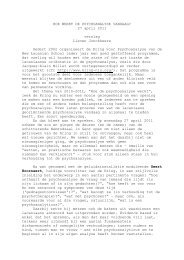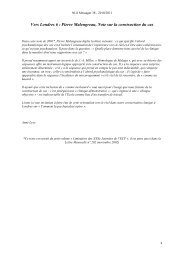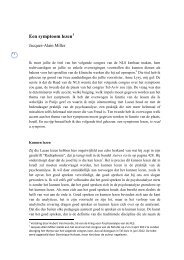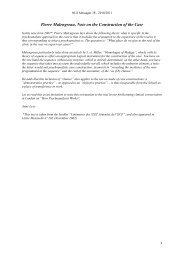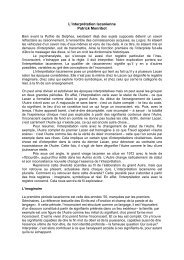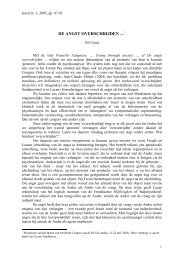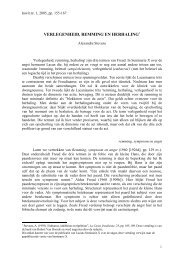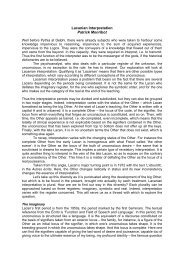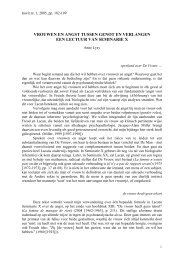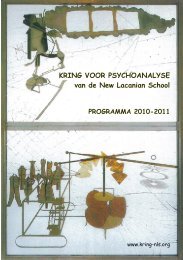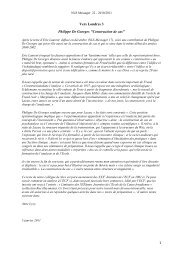Vers Londres 2 Eric Laurent, « Le cas, du - Psychoanalyse Lacan ...
Vers Londres 2 Eric Laurent, « Le cas, du - Psychoanalyse Lacan ...
Vers Londres 2 Eric Laurent, « Le cas, du - Psychoanalyse Lacan ...
Create successful ePaper yourself
Turn your PDF publications into a flip-book with our unique Google optimized e-Paper software.
NLS Messager 17 - 2010/2011<br />
and the same continuous narrative of the subject's dialogue with his unconscious. He also<br />
succeeded in transmitting his mode of narration to Abraham and Ferenczi. His romantic taste<br />
continued to direct him towards a continuation of the German historical novel, towards the<br />
historical dream, presented more or less explicitly as fiction. The splitting of the novelist and his<br />
fiction is always more or less present. It can be read in Jensen's Gradiva or in the biographies,<br />
turned into novels, of cultural heroes like Mereschkowski's 3 <strong>Le</strong>onardo da Vinci. Karl Abraham<br />
and Otto Rank were very impressed by it. We had to wait for the First World War and the study<br />
on the “Wolf Man” to break with these ancient forms. It was to be the last Freudian “<strong>cas</strong>e” to<br />
take the classic form of the “<strong>cas</strong>e study”.<br />
Literature seized upon the resources of the Freudian <strong>cas</strong>e study in order to extricate itself from<br />
conventional forms. Schnitzler's Traumnovelle, which dates back to 1926, uses Freud to force<br />
literature to say more about the sexual content of a subject's behaviour. It was in 1925 that<br />
Alban Berg wanted to turn Bűchner's Woyzeck – whose drama includes clinical papers and<br />
forensic news items – into an opera. Automatic writing, exquisite corpses, the critical paranoia<br />
method, interior monologue and the continuous stream of thoughts became as many places of<br />
experimentation for the new literature. Tastes changed. This put literature and <strong>cas</strong>e studies in<br />
perspective at the moment when, in psychoanalysis, at the “turning point of the 1920s” - there<br />
was a crisis in the practice of interpretation – and this had an effect on the model of the<br />
narrative of the dream and its associations. The “crisis of interpretation” of the 1920s put the<br />
practice of the <strong>cas</strong>e study in jeopardy. Instead of a triumphant association resulting in the<br />
demise of a symptom, psychoanalysts are faced with a symptom that resists the unveiling of the<br />
unconscious. “Case-studies” come to account for the difficulties of each person as well as for the<br />
extension of psychoanalysis there where dreams do not have the same currency, in psychosis<br />
for example. Far more than for the Freudian model, it is the unit of the psychoanalytic session<br />
which is being recounted. Authors try to make their narratives coincide with their practice. The<br />
dream of a laboratory notebook underlies this extraction of the crucial moments of a session.<br />
The unit of the <strong>cas</strong>e study was no longer the destiny of a given subject, but the memorable and<br />
transmissible fact, extracted from a session. The short form was to prevail. Melanie Klein<br />
invented a new form, the modality of the record of experience, session by session. The<br />
“material”, immediately translated into “unconscious” terms by a contribution of the<br />
psychoanalyst of the same length, turned upside down the way Freudian narratives were<br />
organised. The interest is focused on what we would call “the epiphany” proper to each session,<br />
a manifestation of the unconscious in its materiality and a demonstration of the “savoir faire”<br />
*“know how”+ of the psychoanalyst. She only managed to circumvent the question of publication<br />
difficulties by delaying the publication of her analysis of a 10-year old child (Narrative of a Child<br />
Analysis) until her death (1960). In this way, she maintained the extensive form of the<br />
monograph. It was however to be the last published monograph.<br />
Things would evolve into the clinical vignette, the brief clinical form, at the same time as<br />
literature in the broader sense adopted the Freudian proce<strong>du</strong>res to turn it into a new literary<br />
object. At the same time also as people no longer took responsibility for “psychoanalysis” as<br />
such, but devoted themselves to illustrating only one partial aspect of it.<br />
From History to Logic<br />
3<br />
Published in <strong>Le</strong>ipzig in 1911, it inspired Freud for his study of Limard.<br />
4



